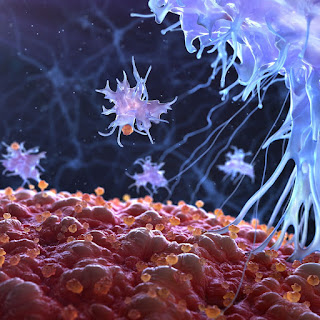There is a hidden symmetry between pregnancy and cancer.
In both, tissues must grow rapidly, blood vessels must expand into new territories, and the body must decide whether to permit or restrain invasion. What determines the difference between a nurturing womb and a growing tumor may lie in how a few molecular players — p53, estrogen receptors, natural killer (NK) cells, and VEGF/FLT1 — coordinate their dance around oxygen, stress, and the extracellular matrix.
The Signal: p53 Meets Estrogen at the FLT1 Gene
In 2010, a PLOS ONE study by Ciribilli et al. uncovered a remarkable piece of the puzzle.
The researchers found that the FLT1 gene — which encodes VEGFR-1, a receptor that senses vascular growth factors — carries a tiny DNA variation (a promoter SNP) that can create a p53 response element. But here’s the twist: p53 doesn’t act alone. It activates FLT1 only when estrogen receptor α (ERα) is nearby, bound to its own DNA half-sites.
This means that p53, often called the guardian of the genome, cooperates with estrogen signaling to tune the sensitivity of blood vessels to VEGF and PlGF, the key drivers of angiogenesis. The study also showed that this activation happens after genotoxic stress such as doxorubicin, but not after other DNA-damaging agents like 5-fluorouracil, underscoring how specific the stress context must be.
In parallel, hypoxia — low oxygen levels — can activate the same FLT1 promoter through HIF-1α. Under these conditions, tissues produce not only the full receptor FLT1 but also its soluble form (sFlt-1), which soaks up VEGF and PlGF like a sponge. It’s a perfect tuning mechanism: too much sFlt-1, and angiogenesis is blocked; too little, and blood vessels grow unchecked.
The Uterine Parallel: The Angiogenic Flood
A decade later, this molecular logic finds a physiological echo in early pregnancy. In The Angiogenic Growth Factor Flood, I explored how natural killer (NK) cells in the uterine lining (the decidua) create a surge of angiogenic growth factors just before and during implantation.
These decidual NK (dNK) cells express a2V-ATPase, acidifying the extracellular matrix and activating MMP-9, a powerful enzyme that cuts through collagen and releases growth factors bound within the ECM. The result is a literal flood of VEGF and PlGF — the same molecules p53 and ERα regulate through FLT1 expression.
Independent research confirms this choreography. During the first trimester, dNK cells secrete VEGF-C, PlGF, Angiopoietin-1/2, and MMP-2/-9, guiding spiral artery remodeling — the vital widening of maternal arteries that ensures proper blood flow to the placenta (Sojka et al., Frontiers in Immunology 2022). If this process falters, preeclampsia can develop, a condition marked by shallow invasion, high vascular resistance, and — notably — elevated sFlt-1 levels in maternal blood (Levine et al., NEJM 2004).
Two Layers, One Circuit
Taken together, these findings reveal a single two-layered circuit:
-
The receptor layer –
p53, ERα, and HIFs determine how much FLT1/sFlt-1 the tissue expresses, setting its sensitivity to VEGF and PlGF. -
The matrix layer –
NK cells and trophoblasts remodel the ECM via a2V-ATPase and MMP-9, controlling the availability of those same VEGF and PlGF molecules.
When these layers synchronize, arterial remodeling proceeds smoothly: arteries dilate, resistance drops, and the embryo receives life-sustaining flow. When they desynchronize, the results diverge — preeclampsia in pregnancy, or uncontrolled angiogenesis in tumors.
From the Womb to the Tumor
It’s no coincidence that cancer co-opts the same program. Hypoxic tumor microenvironments stabilize HIF-1α and HIF-2α, driving VEGF and FLT1 expression much like the early placenta. Meanwhile, matrix metalloproteinases (MMPs) — especially MMP-9 — break down ECM barriers and unleash angiogenic factors, supporting invasion and metastasis. Some tumors even enlist NK-like cells that, paradoxically, promote angiogenesis rather than suppress it (Gao et al., Nature Reviews Immunology 2017).
The difference is control. In pregnancy, p53 remains intact but functionally moderated, allowing invasion to stop at the right depth. In cancer, p53 mutations or inactivation remove that restraint, unleashing angiogenesis without limit. Wild-type p53 can also induce thrombospondin-1, an anti-angiogenic protein, and repress VEGF itself (Teodoro et al., Nature Cell Biology 2006). When p53 is lost, that brake disappears.
Lessons in Balance
The elegance of this system lies in its balance. The sFlt-1/PlGF ratio, now used clinically to predict preeclampsia, captures that equilibrium numerically (Zeisler et al., NEJM 2016). Too much soluble receptor, and the flood is dammed; too little, and angiogenesis runs wild.
The parallels between the placenta and the tumor remind us that biology reuses its best designs — sometimes for creation, sometimes for destruction. Both depend on oxygen gradients, immune-matrix crosstalk, and the nuanced cooperation of p53, ERα, HIFs, and NK-cell proteases.
Looking Ahead
Understanding this unified circuit opens therapeutic possibilities on both fronts:
-
In obstetrics, modulating the sFlt-1/PlGF balance and supporting healthy NK/trophoblast-matrix signaling may prevent or reverse preeclampsia.
-
In oncology, restoring p53 function, adjusting ER context, or tempering HIF-driven FLT1 and MMP-9 activity could re-normalize tumor vasculature.
-
In both, recognizing NK cells as angiogenic regulators — not just killers — reframes how immune therapy and vascular therapy intersect.
Further Reading
-
The Coordinated p53 and Estrogen Receptor Cis-Regulation at an FLT1 Promoter SNP — PLOS ONE (2010)
-
Sojka et al., Front Immunol 2022 – Uterine NK cells and spiral artery remodeling
-
Zeisler et al., NEJM 2016 – sFlt-1/PlGF ratio for preeclampsia prediction
-
Teodoro et al., Nat Cell Biol 2006 – p53 repression of VEGF via thrombospondin-1
-
Gao et al., Nat Rev Immunol 2017 – NK cells in angiogenesis and cancer















